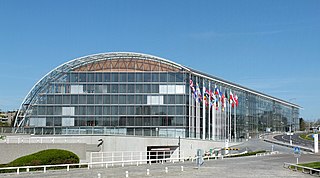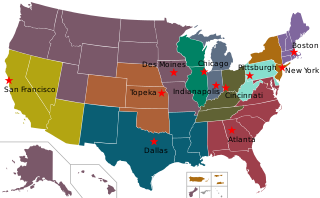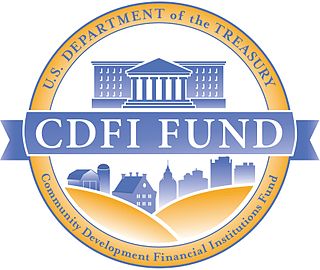Related Research Articles

A capital market is a financial market in which long-term debt or equity-backed securities are bought and sold, in contrast to a money market where short-term debt is bought and sold. Capital markets channel the wealth of savers to those who can put it to long-term productive use, such as companies or governments making long-term investments. Financial regulators like Securities and Exchange Board of India (SEBI), Bank of England (BoE) and the U.S. Securities and Exchange Commission (SEC) oversee capital markets to protect investors against fraud, among other duties.

The European Investment Bank (EIB) is the European Union's investment bank and is owned by the EU Member States. It is one of the largest supranational lenders in the world. The EIB finances and invests both through equity and debt solutions projects that achieve the policy aims of the European Union through loans, guarantees and technical assistance.

The money market is a component of the economy that provides short-term funds. The money market deals in short-term loans, generally for a period of a year or less.
A financial intermediary is an institution or individual that serves as a middleman among diverse parties in order to facilitate financial transactions. Common types include commercial banks, investment banks, stockbrokers, pooled investment funds, and stock exchanges. Financial intermediaries reallocate otherwise uninvested capital to productive enterprises through a variety of debt, equity, or hybrid stakeholding structures.

The Federal Home Loan Banks are 11 U.S. government-sponsored banks that provide liquidity to the members of financial institutions to support housing finance and community investment.

A syndicated loan is one that is provided by a group of lenders and is structured, arranged, and administered by one or several commercial banks or investment banks known as lead arrangers.
Community development bank (CDB) or Community Development Financial Institution (CDFI) is a development bank or credit union that focus on serving people who have been locked out of the traditional financial systems such as the unbanked or underbanked in deprived local communities. They emphasize the long term development of communities and provide loans such as micro-finance or venture capital.

The Community Development Financial Institutions Fund promotes economic revitalization in distressed communities throughout the United States by providing financial assistance and information to community development financial institutions (CDFI). An agency of the United States Department of the Treasury, it was established through the Riegle Community Development and Regulatory Improvement Act of 1994. Financial institutions, which may include banks, credit unions, loan funds, and community development venture capital funds, can apply to the CDFI Fund for formal certification as a CDFI. As of September 1, 2005, there were 747 certified CDFIs in the U.S. The CDFI Fund offers a variety of financial programs to provide capital to CDFIs, such as the Financial Assistance Program, Technical Assistance Program, Bank Enterprise Award Program, and the New Markets Tax Credit Program.
Chicago Community Loan Fund (CCLF) is a certified community development financial institution (CDFI) that provides loans and grants to community development organizations engaged in affordable housing, social service and economic development initiatives in Chicago.
The New Markets Tax Credit (NMTC) Program is a federal financial program in the United States. It aims to stimulate business and real estate investment in low-income communities in the United States via a federal tax credit. The program is administered by the US Treasury Department's Community Development Financial Institutions Fund and allocated by local Community Development Entities (CDEs) across the United States.
A non-banking financial institution (NBFI) or non-bank financial company (NBFC) is a financial institution that does not have a full banking license or is not supervised by a national or international banking regulatory agency. NBFC facilitate bank-related financial services, such as investment, risk pooling, contractual savings, and market brokering. Examples of these include insurance firms, pawn shops, cashier's check issuers, check cashing locations, payday lending, currency exchanges, and microloan organizations. Alan Greenspan has identified the role of NBFIs in strengthening an economy, as they provide "multiple alternatives to transform an economy's savings into capital investment which act as backup facilities should the primary form of intermediation fail."

The Caisse des dépôts et consignations is a French public sector financial institution created in 1816, and part of the government institutions under the control of the Parliament. Often described as the "investment arm" of the French State, it is defined in the French Monetary and Financial Code as a "public group serving the public interest" and a "long-term investor". Since 2017, Éric Lombard has served as its CEO.
On March 23, 2009, the United States Federal Deposit Insurance Corporation (FDIC), the Federal Reserve, and the United States Treasury Department announced the Public–Private Investment Program for Legacy Assets. The program is designed to provide liquidity for so-called "toxic assets" on the balance sheets of financial institutions. This program is one of the initiatives coming out of the implementation of the Troubled Asset Relief Program (TARP) as implemented by the U.S. Treasury under Secretary Timothy Geithner. The major stock market indexes in the United States rallied on the day of the announcement rising by over six percent with the shares of bank stocks leading the way. As of early June 2009, the program had not been implemented yet and was considered delayed. Yet, the Legacy Securities Program implemented by the Federal Reserve has begun by fall 2009 and the Legacy Loans Program is being tested by the FDIC. The proposed size of the program has been drastically reduced relative to its proposed size when it was rolled out.
Opportunity finance refers to socially responsible investing by an institution in an organization or group of individuals.

The financial crisis of 2008, or Global Financial Crisis (GFC), was a severe worldwide economic crisis that occurred in the early 21st century. It was the most serious financial crisis since the Great Depression (1929). Predatory lending targeting low-income homebuyers, excessive risk-taking by global financial institutions, and the bursting of the United States housing bubble culminated in a "perfect storm." Mortgage-backed securities (MBS) tied to American real estate, as well as a vast web of derivatives linked to those MBS, collapsed in value. Financial institutions worldwide suffered severe damage, reaching a climax with the bankruptcy of Lehman Brothers on September 15, 2008, and a subsequent international banking crisis.
The Support Center is a not-for-profit organization and a community development financial institution(CDFI), based in Raleigh, North Carolina. It is a statewide nonprofit that partners with Community Development Credit Unions (CDCUs) and community-based organizations to provide small business and mortgage lending services to its members; and to provide training, grants, and loans to create economic opportunities for individuals, families, and communities in underserved markets.

The Local Initiatives Support Corporation (LISC) is a US non-profit community development financial institution (CDFI) that supports community development initiatives across the country. It has offices in nearly 40 cities and works across 2,100 rural counties in 44 states. LISC was created in 1979 by executives from the Ford Foundation. LISC's affiliates include the National Equity Fund (NEF), the largest national syndicator of Low Income Housing Tax Credits (LIHTC), the New Markets Support Company, a national syndicator of New Markets Tax Credits, and immito, which specializes in SBA 7a lending.
SoFi Technologies, Inc. is an American online personal finance company and online bank. Based in San Francisco, SoFi provides financial products including student and auto loan refinancing, mortgages, personal loans, credit card, investing, and banking through both mobile app and desktop interfaces.

Capital Impact Partners, or simply Capital Impact, is a congressionally chartered, District of Columbia nonprofit and certified community development financial institution that provides credit and financial services to underserved markets and populations in the United States. S&P Global issued Capital Impact its first rating in 2017.
A green bank is a financial institution, typically public or quasi-public, that uses innovative financing techniques and market development tools in partnership with the private sector to accelerate deployment of clean energy technologies. Green banks use public funds to leverage private investment in clean energy technologies that, despite being commercially viable, have struggled to establish a widespread presence in consumer markets. Green banks seek to reduce energy costs for ratepayers, stimulate private sector investment and economic activity, and expedite the transition to a low-carbon economy.
References
- ↑ Comparing Different Types of CDFIs. CDFI Coalition.
- ↑ Russell, Corinne; Mullin, Stefanie (29 December 2009), FHFA Sends Final Rule to Federal Register for CDFIs to Become Members of FHLBs (PDF), Federal Housing Finance Agency, archived from the original (Press release) on 27 May 2010
- ↑ Federal Housing Finance Board; Federal Housing Finance Agency (23 December 2009), Federal Home Loan Bank Membership for Community Development Financial Institutions (PDF), archived from the original (Final Rule) on 21 July 2011
- ↑ "SEC - CNote Offering Circular". SEC.gov. August 29, 2017.
- ↑ "CNote is now available to all investors! | CNote's Official Blog". CNote's Official Blog. 2017-09-27. Retrieved 2017-10-12.
- ↑ Industry Statistics Archived 2007-01-27 at the Wayback Machine , Opportunity Finance
- ↑ CDFI List by Name Archived 2009-05-06 at the Wayback Machine
- ↑ Certified Native CDFIs by Name [ permanent dead link ]
- ↑ Certified CDEs by Name Archived 2009-05-06 at the Wayback Machine
- ↑ "Fact Sheet, COMMUNITY DEVELOPMENT FINANCIAL INSTITUTIONS PROGRAM" (PDF). www.cdfifund.gov. Archived from the original (PDF) on August 7, 2017. Retrieved August 6, 2017.
- ↑ Carpenter, Dave (12 June 2007). "'Bank with a heart' thrives". Spokesman-Review. Retrieved 11 August 2017.
- ↑ "Self-Help Credit Union - North Carolina Credit Union". www.selfhelp.org. Retrieved 11 August 2017.
- ↑ "These Tough Lending Laws Could Travel". Archived from the original on 2009-01-06. Retrieved 2008-11-16.
- ↑ "Subprime guru drives debate". politico.com. Retrieved 11 August 2017.